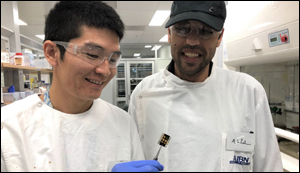Next-gen solar cells spin in new direction
24. 6. 2019 | Flinders University | www.flinders.edu.au
A new nanomaterial made from phosphorus, known as phosphorene, is shaping up as a key ingredient for more sustainable and efficient next-generation perovskite solar cells (PSCs).
PSCs which are one of the fastest developing new solar technologies and can achieve efficiencies comparable to more commonly used commercially available silicon solar cells. For the first time, an international team of clean chemistry researchers led by Professor Joseph Shapter and Flinders University, has made very thin phosphorene nanosheets for low-temperature PSCs using the rapid shear stress of the University’s revolutionary vortex fluidic device (VFD).

“We’ve found exciting new way to convert exfoliated black phosphorus into phosphorene which can help produce more efficient and also potentially cheaper solar cells,” says Dr Christopher Gibson, from the College of Science and Engineering at Flinders University. “Our latest experiments have improved the potential of phosphorene in solar cells, showing an extra Star efficiency of 2%-3% in electricity production.”
Read more at Flinders University
Image Credit: Joe Shapter
-jk-




